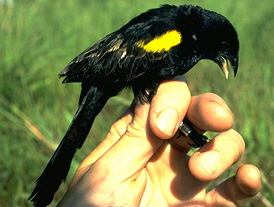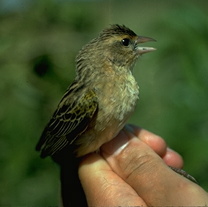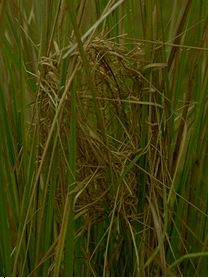
Male Yellow-shouldered Widowbird

Female Yellow-shouldered Widowbird

Male Yellow-shouldered Widowbird |

Female Yellow-shouldered Widowbird |
My dissertation research involved field experimentation with yellow-shouldered widowbirds, Euplectes macrourus , in Kenya. This species is closely related to the famous long-tailed widowbird studied by Malte Andersson, but breeding males  have a much shorter tail (though still longer than in females or non-breeding males). My goal was to more rigorously test alternatives to female choice for the evolution of long tails, as well as to identify reasons for the considerable geographic and interspecific variation in male tail length within the widowbirds (tail length in the genus Euplectes varies from 3 to 50 cm). Using experimental manipulations of tail length, I demonstrated that tail length functions primarily in male-male competition for territories (males with shortened tails lost their territories more frequently than did control or tail-lengthened males). On the other hand, I found no evidence for female choice of long-tailed males, using either natural variation or experimentally manipulated tails. Instead, female preferences were for males that built numerous nest frames (see picture to right), and more weakly, for certain territory attributes. Thus, my studies ran counter to Andersson's findings with long-tailed widowbirds which emphasised the
importance of female choice for long tails; it is possible that this difference accounts for the differences in tail length between these species. My work clearly showed that male-male competition--and not just female choice--can lead to the evolution of conspicuous, sexually dimorphic ornaments.
have a much shorter tail (though still longer than in females or non-breeding males). My goal was to more rigorously test alternatives to female choice for the evolution of long tails, as well as to identify reasons for the considerable geographic and interspecific variation in male tail length within the widowbirds (tail length in the genus Euplectes varies from 3 to 50 cm). Using experimental manipulations of tail length, I demonstrated that tail length functions primarily in male-male competition for territories (males with shortened tails lost their territories more frequently than did control or tail-lengthened males). On the other hand, I found no evidence for female choice of long-tailed males, using either natural variation or experimentally manipulated tails. Instead, female preferences were for males that built numerous nest frames (see picture to right), and more weakly, for certain territory attributes. Thus, my studies ran counter to Andersson's findings with long-tailed widowbirds which emphasised the
importance of female choice for long tails; it is possible that this difference accounts for the differences in tail length between these species. My work clearly showed that male-male competition--and not just female choice--can lead to the evolution of conspicuous, sexually dimorphic ornaments.
In addition to examining the role of sexual selection, I also considered non-sexual selection alternatives to the evolution of long tails, something that is rarely ever done in the sexual selection literature. I specifically examined the species recognition, aposematism/unprofitable prey, and genetic drift hypotheses using both field data and a comparative approach. Manipulation of tail length in yellow-shouldered widowbirds did not influence male pairing success and did not affect interactions with congeners that shared their territories. Furthermore, a comparative study of tail lengths based on museum specimens did not show any clear patterns of tail length divergence in areas of sympatry, as predicted by the species-recognition hypothesis. Both of these results suggest that species recognition is not a function of varied tail lengths in widowbirds. The aposematism hypothesis can also be rejected since it is inconsistent with the considerable variation in tail length (such signals should converge rather than diverge) and lack of clear patterns of character convergence (again based on museum specimens), as well as a lack of a relationship between tail length and palatability (the latter obtained from the literature). I was unable to reject genetic drift as a possible explanation for interpopulation variation in tail length (despite the considerable variation and evidence of directional selection on tail length in three species); this may be due in part to inaccuracies in estimating several of the parameters of the genetic model used. Thus, my work differs from most research on sexual selection in that I considered and tested various alternatives that could also account for long male tails.
Despite evidence that sexual selection favors long tails in three species of widowbirds, it is still not clear why there is so much geographic and interspecific variation in tail length. One possibility that I already mentioned is that it is due to different modes of sexual selection: in the species in which male-male competition is more important, tails are relatively short (100 cm), while in species in which female choice is more important, tails are longer (>250 cm). Currently there is neither the empirical nor theoretical basis to indicate whether female choice should lead to more extravagant traits than male-male competition, and this is an area worthy of further investigation. Another possibility is that the cost of having long tails varies between species. One possible cost is that long tails make flight difficult in rain (the water itself and the impact of the drops would weigh down the birds; long-tailed widowbirds are incapable of flying in the rain). This possibility is supported by my comparative study which showed that species living in drier climates tend to have longer tails than those in wetter climates (the trends persist even when phylogenetic effects are partly controlled for).
Savalli, U.M. 1994. Mate choice in the yellow-shouldered widowbird: correlates of male attractiveness. Behavioral Ecology and Sociobiology 35: 227-234.
Recent investigations of male ornaments in sexual selection have used experimental manipulation of tail length in three widowbirds species, but only for one of these have correlates of male reproductive success been reported. I examined correlates of male attractiveness to nesting females over two breeding seasons for the polygynous yellow-shouldered widowbird, Euplectes macrourus , in order to discover which cues females may be using to select mates. The black, long-tailed ( 10 cm) males defend large territories and build nest frames, or cock's nests, which females then line and use for nesting. I examined various aspects of male morphology, five behavioral displays, territory characteristics, and the number of cock's nests that males built. Few correlates of mating success were found. The best predictor was the number of cock's nests that a male builds, though one courtship display also correlated with male mating success in one year, as did average grass height. Tail length did not correlate with male mating success. A partial correlation analysis confirmed that cock's nests and, in one year, grass height, were the primary contributers to male success. Females may choose where to nest primarily on the availability of suitable nesting sites. Long tails may be used by females seeking extra-pair copulations or in male-male competition for territories.
Savalli, U.M. 1995. The evolution of tail-length in widowbirds (Ploceidae): tests of alternatives to sexual selection. Ibis 137: 389-395.
The long tails of male widowbirds (Euplectes, Ploceidae) have been used to test sexual selection theory, but alternatives to sexual selection have not been investigated. This study tests three alternative hypotheses for the evolution of tail-length in widowbirds: aposematism; the unprofitable prey hypothesis; and species recognition. Using museum specimens, geographic patterns of tail-length were examined for evidence of character convergence (as predicted by the aposematism and unprofitable prey hypotheses) or character divergence (as predicted by the species recognition hypothesis) in areas where two pairs of species were sympatric. There was no consistent trend: one species showed evidence of character convergence, and the other some evidence of divergence. Experimental manipulation of tail-length in the Yellow-shouldered Widowbird, E. macrourus , also failed to support the species recognition hypothesis: there was no preference for males with species-typical tail-lengths, but instead a slight, non-significant trend to favour short-tailed males. There was also no evidence that mistaken identity led to territory loss following these experimental manipulations. Tail-length of six Euplectes species did not correlate with unpalatability scores, as predicted by the aposematism hypothesis. These hypotheses do not appear to explain the evolution of long tails in widowbirds, suggesting that sexual selection is the sole factor favouring long tails. Interspecific variation in tail-length remains unexplained.
Savalli, U.M. 1995. Does rainfall constrain the evolution of tail length in widowbirds? Ethology Ecology & Evolution 7: 379-385.
Widowbirds (Euplectes , Ploceidae) are sexually dimorphic weaverbirds in which the males have elongated tails that exhibit a great deal of interspecific variation. One possible cause of such variation is geographic variation in cost due to the possibility that rainfall makes it more difficult to fly. This hypothesis was tested by comparing tail length to the modal and maximum rainfall levels in which the populations occur. Overall, there was a significant negative relationship between maximum rainfall and tail length, and a similar but non-significant trend with modal rainfall. Phylogenetic effects were partially controlled for by testing for the same relationships within two species groups and across species groups: in all cases, the trends were as in the overall test, suggesting that shared descent alone cannot explain the relationship. These results suggest that geographic variation in costs could explain inter-population variation in sexually selected ornaments. Other reasons for the relationship are also possible.
Savalli, U.M. 1997. The role of male territories in the mating system of the Yellow-shouldered Widowbird Euplectes macrourus. Ibis 139: 374-378.
The territorial system and breeding biology of the Yellow-shouldered Widowbird, Euplectes macrourus (Ploceidae) was investigated in western Kenya. Yellow-shouldered Widowbirds have a resource-defence polygynous mating system: males defend large (mean = 0.95 ha) territories and build the coarse framing for the nests in tall grass. Males had up to five females nesting per territory. Females provide nearly all parental care except for a territorial male seen feeding a fledgling: the first observation of paternal care in the wild for this genus. There was considerable variation in territory size but the cause of this variation remains unknown: territory size was not related to potential indicators of territory quality such as grass height and abundance, did not relate to male morphology (mass, size, and ornament size) or territorial behaviour (boundary displays and singing), and did not affect female preferences. Although resources (territories and nests) are defended by the males, observations that males frequently feed outside their territory and form communal roosts during the breeding season, suggest that this species represents a transitional stage between typical resource-defence polygyny and lek-breeding.
See my Kakamega National Forest Page for information about and pictures from my Kenyan study site.
Links to Sites of Related Interest
Matthew Evans--Sexual Selection & Signalling in Birds
Communication Biology Group (Univ. of Witwatersrand)
Carl Bergstrom -- Signalling Theory and Animal Behavior
Honest Signalling Theory: An Online Tutorial
Pheasant Spurs Sexual Selection
David Westneat--Reproductive Tactics in Birds
Rebecca Irwin--Plumage Evolution in Meadowlarks and Blackbirds